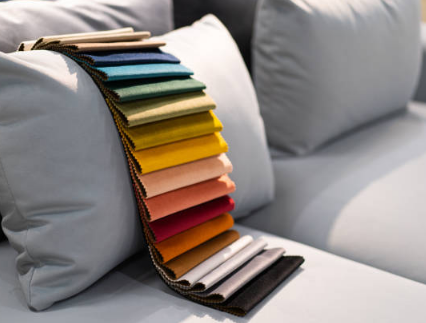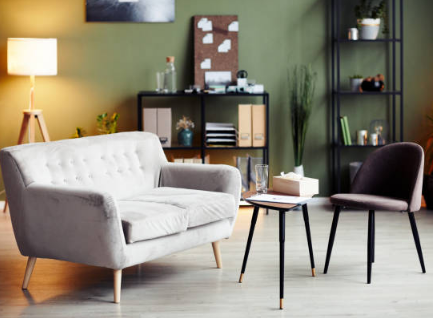
What is a Steam Shower? A Guide to Popular Bathroom Upgrades
February 14, 2025The sofa is the centerpiece of your living space, where you can entertain friends, watch TV, and relax on the weekend. But with so many sofas to choose from, from stylish tufted sofas to set sofas or sectional sofas, choosing this key piece of furniture can be a daunting task. The sofa you choose should take into account all factors – price, comfort, quality, color, and even some additional features like stain-repellent fabrics.
So, how do you choose from various types of sofas that will accentuate your home style and enhance your comfort? To make this task easier, we’ve outlined the most important details you need to know when looking for your next couch.

Choose a Sofa Style
When buying a new sofa, start by choosing a style that complements your design aesthetic.
Formal
Decorating a formal living room or lounge area? Choose a sofa with a tight backrest and seat. Since these sofas don’t have separate cushions, they look neater and feel more traditional. A sofa with a close-back and a loose seat will also help you achieve a neat silhouette while providing more comfort.
Casual
If you’re looking for a more laid-back, functional look, look for a sofa with loose back cushions and seat cushions. Although these iterations tend to be more comfortable, they can appear sloppy over time. A quick fix is to buy a sofa with a good warranty or high-quality cushions.
Elegant
For a classic or European look, try a tufted sofa. These timeless sofas are a perfect match for different furniture styles. Tufted sofas are available in two versions: full tufted (back and seat) or partially tufted (only back or seat cushion, but not both). Although these sofas may be stylish, their stiffer look and feel may not be suitable for nappers or recliners.

What to Consider When Choosing a Sofa Fabric
After choosing the sofa design and padding, it’s time to choose the fabric pragmatically. Although all furniture wears out, choosing the right fabric can keep your sofa looking great for longer and avoid frequent replacement. Start by assessing your lifestyle, who shares your space, and where the sofa is located (and used).
Lifestyle
Do you eat and drink on the couch? Is there a movie night? Think about how you’ll use the couch and the traffic you’ll be experiencing. How long does your family member sit on it in a week? You may need durable fabrics to resist injuries from pets and children. In this case, look for terms such as stain resistance or pet friendly when shopping for sofa upholstery fabrics.

Cleaning Habits
Even if you see the word “stain resistant,” check the care instructions for your sofa. How much time and effort can you put into keeping your couch in good condition? If you’re obsessed with a particular look and are willing to spend more time maintaining it (rather than choosing something that costs less maintenance), go for it! This decision will depend on your lifestyle and design goals. If you can remove and wash the cushion cover of your sofa, the slip cover option may also be a low-maintenance option. Simply wash each lid at the same time so that all parts will fade evenly over time.
The Sofa Is Located in the House
If you’re placing your sofa in a space that’s exposed to sunlight, look for fade/UV-resistant options. If you’re placing your couch outdoors, look for extra features that protect it from mold and moisture.
Sustainable Development
Also consider your values as a shopper. Do you prioritize sustainability? In this case, choose eco-friendly or natural fabrics such as cotton, canvas, linen, or wool.

Personal Touch
For an extra layer of customization, some companies allow you to offer your own fabrics. Look for the term COM (Customer’s Own Materials). Although this may cost extra, it’s an easy way to give any standard sofa a more personalized look.
Choose the Right Sofa Filler
In addition to the style and upholstery fabrics, you also need to choose padding or padding for the sofa. You will encounter three main material options: foam, down, or a mixture of both.
Unlike foam, which springs back to its original shape when you stand up, down is flattened, so re-loosen the sofa cushion regularly. Another downside of the drop? Its feathers may pierce the fabric, so it may fall off and prick you. To get the best of both worlds, choose a combination of two sofa filling materials, such as a cushion with a foam core surrounded by down.
Add Extra Design
Some sofas come with welts (also known as piping) that can give your chair a more premium look. The other sofas are decorated with spike heads. The nail head is available in a variety of metal varieties, including bronze, chrome, brushed gold, and nickel, and looks like jewelry, casting a reflective sheen. Depending on how you want the look, this add-on can create a traditional, modern, or industrial atmosphere.
Sofa legs can also enhance the aesthetic of your design. The three common leg shapes include bun feet, straight feet, and turned feet. Rotating legs give a more antique feel, while straight legs, like tapered wooden legs, have a universal appeal. The bun feet have a curved appearance, giving them a high-end but more traditional feel.

Mode or No Mode?
Whether you choose stripes, flowers, or animal prints, patterns can add vivid details to any space. But seats made of solid fabrics are often more timeless and versatile. With solid colors, you always have the option to refresh your space with a new pattern through curtains, throw pillows, or other décor. But if you choose a patterned sofa, there’s no guarantee that it will align with future design changes.
The Number and Type of Sofa Cushions
Sofas either have multiple cushions or a single cushion, each with advantages and disadvantages.
A single-cushion sofa has a sleek, formal look that looks more combinated than a multi-cushion sofa. Single-cushion sofas also offer more flexible seating, as there are no pre-built seating settings. More people can comfortably squeeze in without worrying about cracks between the cushions, making it easy to create a makeshift sofa bed for napping.
Multi-cushion sofas can also be accommodated because you can move the cushions, which is especially useful if the cushions get dirty. However, these sofas don’t look as crisp as single-cushion sofas.
There are also different types of sofa cushions, including rounded corner cushions, box cushions, and button cushions. The cassette cushion has a square shape and a clear linear character. The edges of the rounded pads have a slight curve for a more fluffy appearance. Button pads add texture and fun, but may feel more stiff.

Focus on Comfort
Each type of sofa has a different height and depth. It’s important to look at these dimensions so you can get the proper support you need. For example, if you suffer from back pain, you’ll want to find a sofa with plenty of back support, so don’t choose a sofa with a short backrest. You can also choose thicker or thinner sofa armrests, depending on how comfortable you feel. You’ll also find sofas with practical features such as built-in reclining, USB charging, magazine or book storage, and cup holders that are more convenient and comfortable.
Measure, Measure, Measure
Before you take any couch home, you have to take a look at your space. This includes doorways, hallways, entrances, and any areas you’ll pass through when transporting your couch. Next, make sure that your couch fits in the room and doesn’t block any walkways. Ideally, the walkway width should be 36 inches. Once you’ve done this, arrange the seats around the couch, leaving about 18 inches between the couch and the coffee table.
Overall, the height, width, and length of the sofa should match the size of your space and architectural elements. For example, if you have a large window, you may want to consider using a sofa with a short backrest to prevent it from interfering with the view. This can help create a more seamless look.
Finally, put functionality first. For example, if you buy a sofa with a recliner, is there enough space to open the sliding glass door? Weigh ahead of time and you’ll find the right option every time. If you struggle with this design task, contact a professional designer or ask your furniture retailer if they offer design or space planning services.

Test It Out
Testing your sofa isn’t always feasible, especially if you bought it online. However, check if the online store has a local showroom in your area and check its return policy. Some furniture stores offer a 30-day money-back guarantee or a testing period. Others may charge a restocking fee or return shipping fee. Keep in mind that if you have the flexibility to observe, feel, and use the couch at home for at least a week, it may give you a perspective that you can’t get by sitting on the couch in a showroom for five to ten minutes.
View the Return Policy and Warranty
Buying a sofa can be a big investment. To avoid regrets later on, it’s a good idea to check the manufacturer’s policy to find out what happens if an item cracks, tears, or gets dirty. By exploring the company’s policies and warranty options, you can protect yourself and your investment in the long run.



